Extreme Value Analysis of Tide Gauge Record at the Port of Busan, South Korea
Abstract
:1. Introduction
2. Materials and Methods
2.1. Data Sources Utilized
2.2. Methodological Approach
3. Results
3.1. Busan Tide Gauge Record (Hourly)
3.2. Extreme Value Analysis
4. Discussion
4.1. Sensitivity of the Early Part of the Tide Guage Record to the EVA
4.2. Rise in the Mean Sea Level and Implications for Extreme Water Level Predictions
4.3. Influence of the Super-Typhoon “Maemi” on the EVA and Predictions for Busan
4.4. Sensitivity of the Random Timing of Storm Surges with the Predicted Tides
4.5. Some Thoughts on the Best Practice EVA for Application to Ocean SWLs
5. Conclusions
Author Contributions
Funding
Data Availability Statement
Conflicts of Interest
References
- World Population Review. Available online: https://worldpopulationreview.com/countries/cities/south-korea (accessed on 6 September 2023).
- World Shipping Council. Available online: https://www.worldshipping.org/top-50-ports (accessed on 6 September 2023).
- Kim, J.-M.; Son, K.; Yum, S.-G.; Ahn, S.; Ferreira, T. Typhoon Vulnerability Analysis in South Korea Utilizing Damage Record of Typhoon Maemi. Adv. Civ. Eng. 2020, 2020, 8885916. [Google Scholar] [CrossRef]
- Lin, I.-I.; Wu, C.-C.; Emanuel, K.A.; Lee, I.-H.; Wu, C.-R.; Pun, I.-F. The Interaction of Supertyphoon Maemi (2003) with a Warm Ocean Eddy. Mon. Weather. Rev. 2005, 133, 2635–2649. [Google Scholar] [CrossRef]
- Lim, D.-U.; Suh, K.-D.; Mori, N. Regional Projection of Future Extreme Wave Heights around Korean Peninsula. Ocean Sci. J. 2013, 48, 439–453. [Google Scholar] [CrossRef]
- Kim, D.-Y.; Park, S.-H.; Woo, S.-B.; Jeong, K.-Y.; Lee, E.-I. Sea Level Rise and Storm Surge around the Southeastern Coast of Korea. J. Coast. Res. 2017, 79, 239–243. [Google Scholar] [CrossRef]
- Ko, D.H.; Jeong, S.T.; Cho, H. Statistical Characteristics of Hourly Tidal Levels around the Korean Peninsula. J. Korean Soc. Coast. Ocean Eng. 2013, 25, 365–373. [Google Scholar] [CrossRef]
- Byun, D.S.; Choi, B.J.; Kim, H. Estimation of the Lowest and Highest Astronomical Tides along the West and South Coast of Korea from 1999 to 2017. Sea J. Korean Soc. Oceanogr. 2019, 24, 495–508. [Google Scholar] [CrossRef]
- Watson, P.J.; Lim, H.S. An Update on the Status of Mean Sea Level Rise around the Korean Peninsula. Atmosphere 2020, 11, 1153. [Google Scholar] [CrossRef]
- Fox-Kemper, B.; Hewitt, H.T.; Xiao, C.; Aðalgeirsdóttir, G.; Drijfhout, S.S.; Edwards, T.L.; Golledge, N.R.; Hemer, M.; Kopp, R.E.; Krinner, G.; et al. Ocean, Cryosphere and Sea Level Change. In Climate Change 2021: The Physical Science Basis. Contribution of Working Group I to the Sixth Assessment Report of the Intergovernmental Panel on Climate Change; Masson-Delmotte, V., Zhai, P., Pirani, A., Connors, S.L., Péan, C., Berger, S., Caud, N., Chen, Y., Goldfarb, L., Gomis, M.I., et al., Eds.; Cambridge University Press: Cambridge, UK; New York, NY, USA, 2021; pp. 1211–1362. [Google Scholar]
- Rashid, M.M.; Wahl, T. Predictability of Extreme Sea Level Variations Along the U.S. Coastline. J. Geophys. Res. Ocean. 2020, 9, e2020JC016295. [Google Scholar] [CrossRef]
- Arns, A.; Wahl, T.; Haigh, I.D.; Jensen, J. Determining Return Water Levels at Ungauged Coastal Sites: A Case Study for Northern Germany. Ocean Dyn. 2015, 65, 539–554. [Google Scholar] [CrossRef]
- Arns, A.; Wahl, T.; Wolff, C.; Vafeidis, A.T.; Haigh, I.D.; Woodworth, P.; Niehüser, S.; Jensen, J. Non-Linear Interaction Modulates Global Extreme Sea Levels, Coastal Flood Exposure, and Impacts. Nat. Commun. 2020, 11, 1918. [Google Scholar] [CrossRef]
- Schindelegger, M.; Green, J.A.M.; Wilmes, S.-B.; Haigh, I.D. Can We Model the Effect of Observed Sea Level Rise on Tides? J. Geophys. Res. Ocean. 2018, 123, 4593–4609. [Google Scholar] [CrossRef]
- Coles, S. An Introduction to Statistical Modeling of Extreme Values; Springer London: London, UK, 2001; ISBN 978-1-84996-874-4. [Google Scholar]
- Dupuis, D.J. Exceedances over High Thresholds: A Guide to Threshold Selection. Extremes 1999, 1, 251–261. [Google Scholar] [CrossRef]
- Arns, A.; Wahl, T.; Haigh, I.D.; Jensen, J.; Pattiaratchi, C. Estimating Extreme Water Level Probabilities: A Comparison of the Direct Methods and Recommendations for Best Practise. Coast. Eng. 2013, 81, 51–66. [Google Scholar] [CrossRef]
- Caires, S. Extreme Value Analysis: Wave Data; (JCOMM Technical Report 57); World Meteorological Organization/JCOMM: Geneva, Switzerland, 2011; 33p. [Google Scholar] [CrossRef]
- Watson, P.J. Extreme Value Analysis of Ocean Still Water Levels along the USA East Coast—Case Study (Key West, Florida). Coasts 2023, 3, 294–312. [Google Scholar] [CrossRef]
- R Development Core Team. R: A Language and Environment for Statistical Computing, Version 4.3.2; R Foundation for Statistical Computing: Vienna, Austria, 2023. Available online: https://www.r-project.org/(accessed on 29 November 2023).
- Gilleland, E.; Katz, R.W. ExtRemes 2.0: An Extreme Value Analysis Package in R. J. Stat. Softw. 2016, 72, 39. [Google Scholar] [CrossRef]
- Garner, G.G.; Kopp, R.E.; Hermans, T.; Slangen, A.B.A.; Edwards, T.L.; Levermann, A.; Nowikci, S.; Palmer, M.D.; Smith, C.; Fox-Kemper, B.; et al. IPCC AR6 Sea-Level Rise Projections, Version 20210809; PO.DAAC: Pasadena, CA, USA, 2021.
- Garner, G.G.; Kopp, R.E.; Hermans, T.; Slangen, A.B.A.; Koubbe, G.; Turilli, M.; Jha, S.; Edwards, T.L.; Levermann, A.; Nowikci, S.; et al. Framework for Assessing Changes To Sea-Level (FACTS). Geosci. Model Dev. 2022. [Google Scholar] [CrossRef]
- Japan Meterological Organisation. Regional Specialized Meteorological Center (RSMC) Tokyo—Typhoon Center. Available online: https://www.jma.go.jp/jma/jma-eng/jma-center/rsmc-hp-pub-eg/trackarchives.html (accessed on 1 June 2023).
- Embrechts, P.; Klüppelberg, C.; Mikosch, T. Modelling Extremal Events; Springer: Berlin/Heidelberg, Germany, 1997; ISBN 978-3-642-08242-9. [Google Scholar]
- Ramachandra Rao, A.; Hamed, K.H. (Eds.) Flood Frequency Analysis; CRC Press: Boca Raton, FL, USA, 2019; ISBN 9780429128813. [Google Scholar]
- Gumbel, E.J. Statistics of Extremes; Columbia University Press: New York, NY, USA, 1958. [Google Scholar] [CrossRef]
- Beirlant, J.; Goegebeur, Y.; Teugels, J.; Segers, J. Statistics of Extremes; John Wiley & Sons, Ltd.: Chichester, UK, 2004; ISBN 9780470012383. [Google Scholar]
- Pickands, J. Statistical Inference Using Extreme Order Statistics. Ann. Stat. 1975, 3, 119–131. [Google Scholar]
- Watson, P.J. Status of Mean Sea Level Rise around the USA (2020). GeoHazards 2021, 2, 80–100. [Google Scholar] [CrossRef]
- Watson, P.J. Identifying the Best Performing Time Series Analytics for Sea Level Research. In Time Series Analysis and Forecasting: Contributions to Statistics; Rojas, I., Pomares, H., Eds.; Springer International Publishing: Berlin/Heidelberg, Germany, 2016; pp. 261–278. [Google Scholar]
- Watson, P.J. Improved Techniques to Estimate Mean Sea Level, Velocity and Acceleration from Long Ocean Water Level Time Series to Augment Sea Level (and Climate Change) Research. Ph.D. Thesis, University of New South Wales, Sydney, Australia, 2018. [Google Scholar]
- Kondrashov, D.; Ghil, M. Spatio-Temporal Filling of Missing Points in Geophysical Data Sets. Nonlinear Process. Geophys. 2006, 13, 151–159. [Google Scholar] [CrossRef]
- Golyandina, N.; Korobeynikov, A.; Zhigljavsky, A. Singular Spectrum Analysis with R; Springer: Berlin/Heidelberg, Germany, 2018; ISBN 9783662573785. [Google Scholar]
- Watson, P.J. TrendSLR: Estimating Trend, Velocity and Acceleration from Sea Level Records, Version 1.0. In Extension Software Package in R; 2019; Available online: https://cran.r-project.org/web/packages/TrendSLR/index.html (accessed on 29 November 2023).
- Houston, J.R.; Dean, R.G. Effects of Sea-Level Decadal Variability on Acceleration and Trend Difference. J. Coast. Res. 2013, 29, 1062–1072. [Google Scholar] [CrossRef]
- Katz, R.W.; Parlange, M.B.; Naveau, P. Statistics of Extremes in Hydrology. Adv. Water Resour. 2002, 25, 1287–1304. [Google Scholar] [CrossRef]
- Watson, P.J. Determining Extreme Still Water Levels for Design and Planning Purposes Incorporating Sea Level Rise: Sydney, Australia. Atmosphere 2022, 13, 95. [Google Scholar] [CrossRef]
- Ghosh, S.; Resnick, S. A Discussion on Mean Excess Plots. Stoch. Process. Their Appl. 2010, 120, 1492–1517. [Google Scholar] [CrossRef]
- Scarrott, C.; MacDonald, A. A Review of Extreme Value Threshold Estimation and Uncertainty Quantification. REVSTAT-Stat. J. 2012, 10, 33–60. [Google Scholar]
- Thompson, P.; Cai, Y.; Reeve, D.; Stander, J. Automated Threshold Selection Methods for Extreme Wave Analysis. Coast. Eng. 2009, 56, 1013–1021. [Google Scholar] [CrossRef]
- Davison, A.C.; Smith, R.L. Models for Exceedances Over High Thresholds. J. R. Stat. Soc. Ser. B (Methodol.) 1990, 52, 393–425. [Google Scholar] [CrossRef]
- Teena, N.V.; Sanil Kumar, V.; Sudheesh, K.; Sajeev, R. Statistical Analysis on Extreme Wave Height. Nat. Hazard. 2012, 64, 223–236. [Google Scholar] [CrossRef]
- Park, D.-S.R.; Ho, C.-H.; Kim, J.-H.; Kim, H.-S. Strong Landfall Typhoons in Korea and Japan in a Recent Decade. J. Geophys. Res. 2011, 116, D07105. [Google Scholar] [CrossRef]
- Wu, M.C.; Chang, W.L.; Leung, W.M. Impacts of El Niño–Southern Oscillation Events on Tropical Cyclone Landfalling Activity in the Western North Pacific. J. Clim. 2004, 17, 1419–1428. [Google Scholar] [CrossRef]
- Kim, J.-H.; Ho, C.-H.; Sui, C.-H.; Park, S.K. Dipole Structure of Interannual Variations in Summertime Tropical Cyclone Activity over East Asia. J. Clim. 2005, 18, 5344–5356. [Google Scholar] [CrossRef]
- Choi, K.-S.; Kim, B.-J. Climatological Characteristics of Tropical Cyclones Making Landfall over the Korean Peninsula. J. Korean Meteorol. Soc. 2007, 43, 97–109. [Google Scholar]
- Hawkes, P.J.; Gonzalez-Marco, D.; Sánchez-Arcilla, A.; Prinos, P. Best Practice for the Estimation of Extremes: A Review. J. Hydraul. Res. 2008, 46, 324–332. [Google Scholar] [CrossRef]
- Park, K.-S.; Heo, K.-Y.; Jun, K.; Kwon, J.-I.; Kim, J.; Choi, J.-Y.; Cho, K.-H.; Choi, B.-J.; Seo, S.-N.; Kim, Y.H.; et al. Development of the Operational Oceanographic System of Korea. Ocean Sci. J. 2015, 50, 353–369. [Google Scholar] [CrossRef]
- Dangendorf, S.; Arns, A.; Pinto, J.G.; Ludwig, P.; Jensen, J. The Exceptional Influence of Storm ‘Xaver’ on Design Water Levels in the German Bight. Environ. Res. Lett. 2016, 11, 054001. [Google Scholar] [CrossRef]

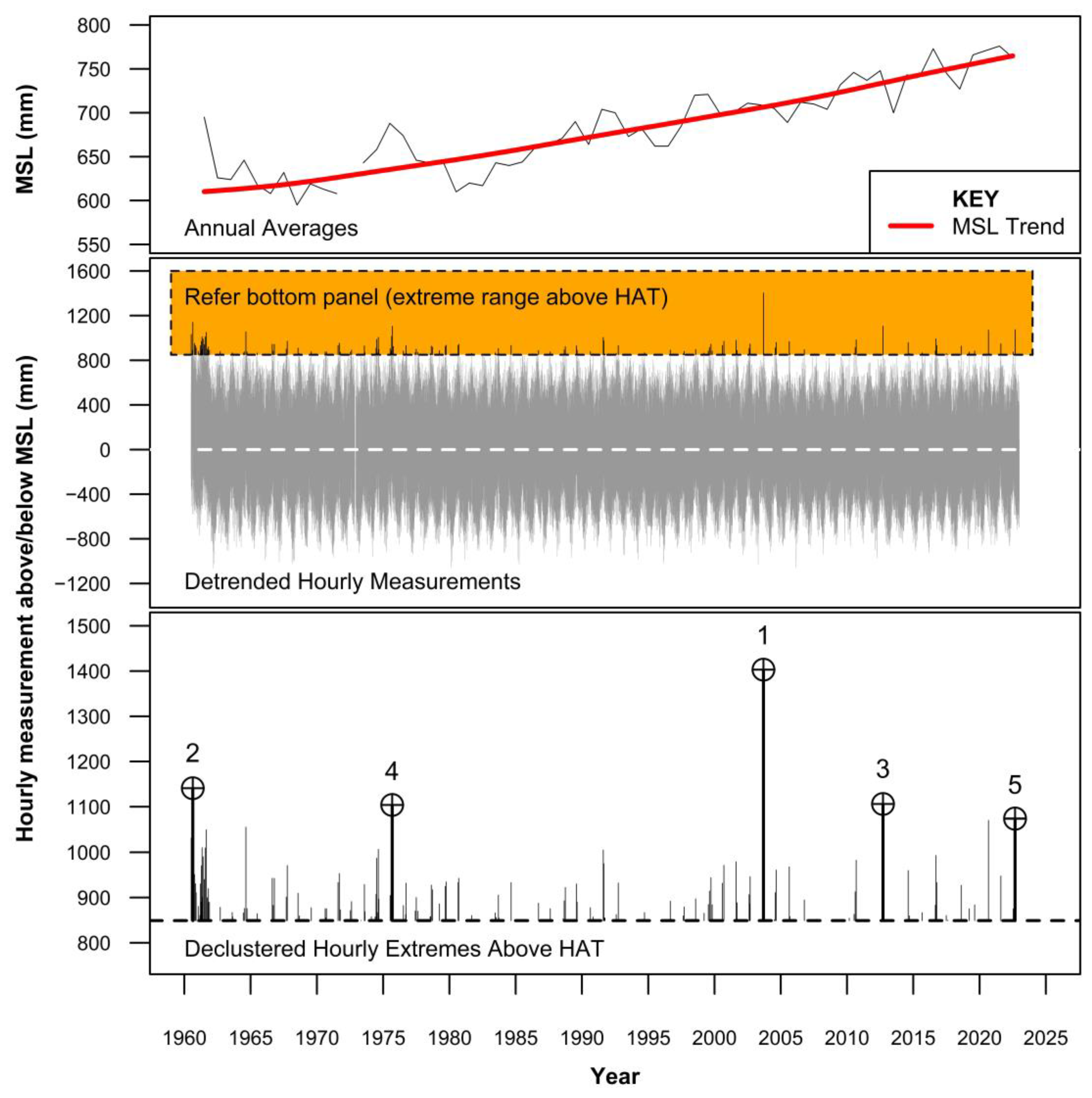

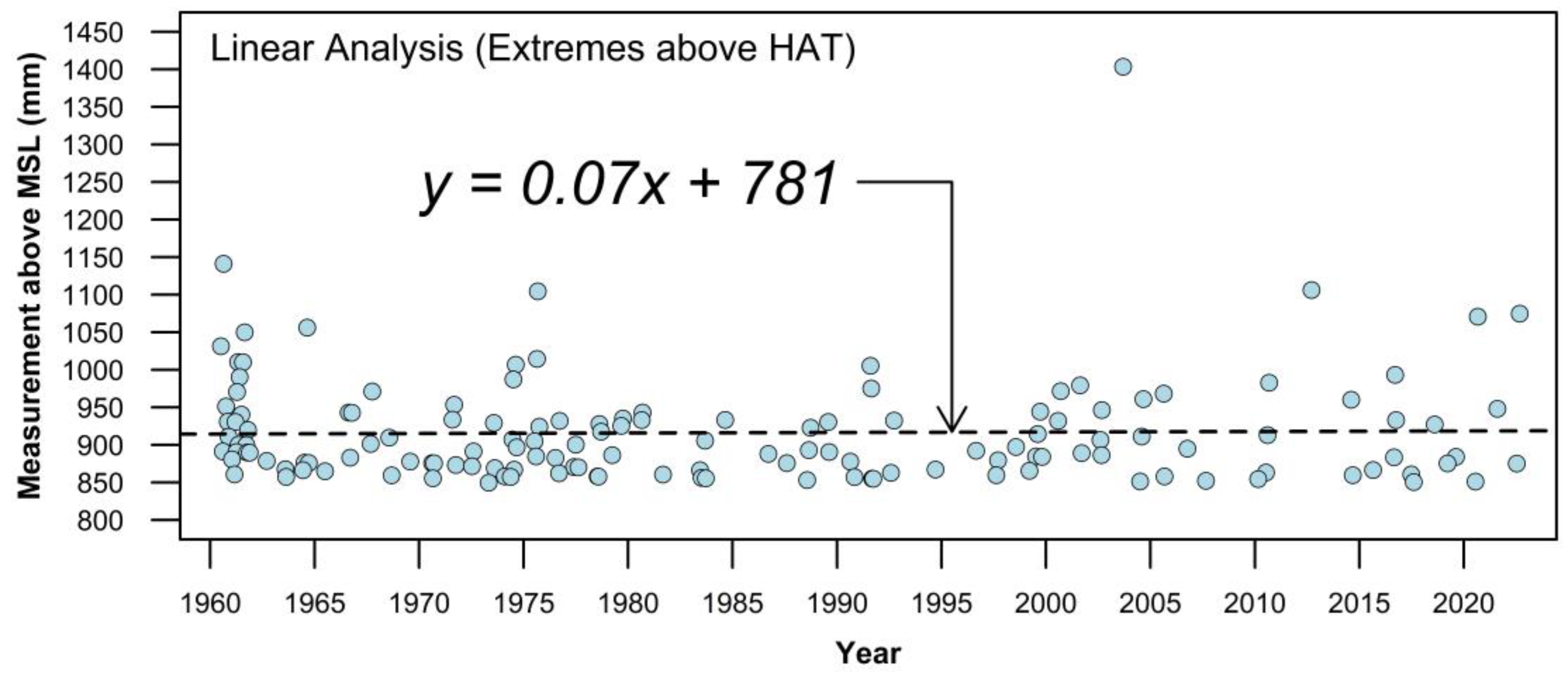
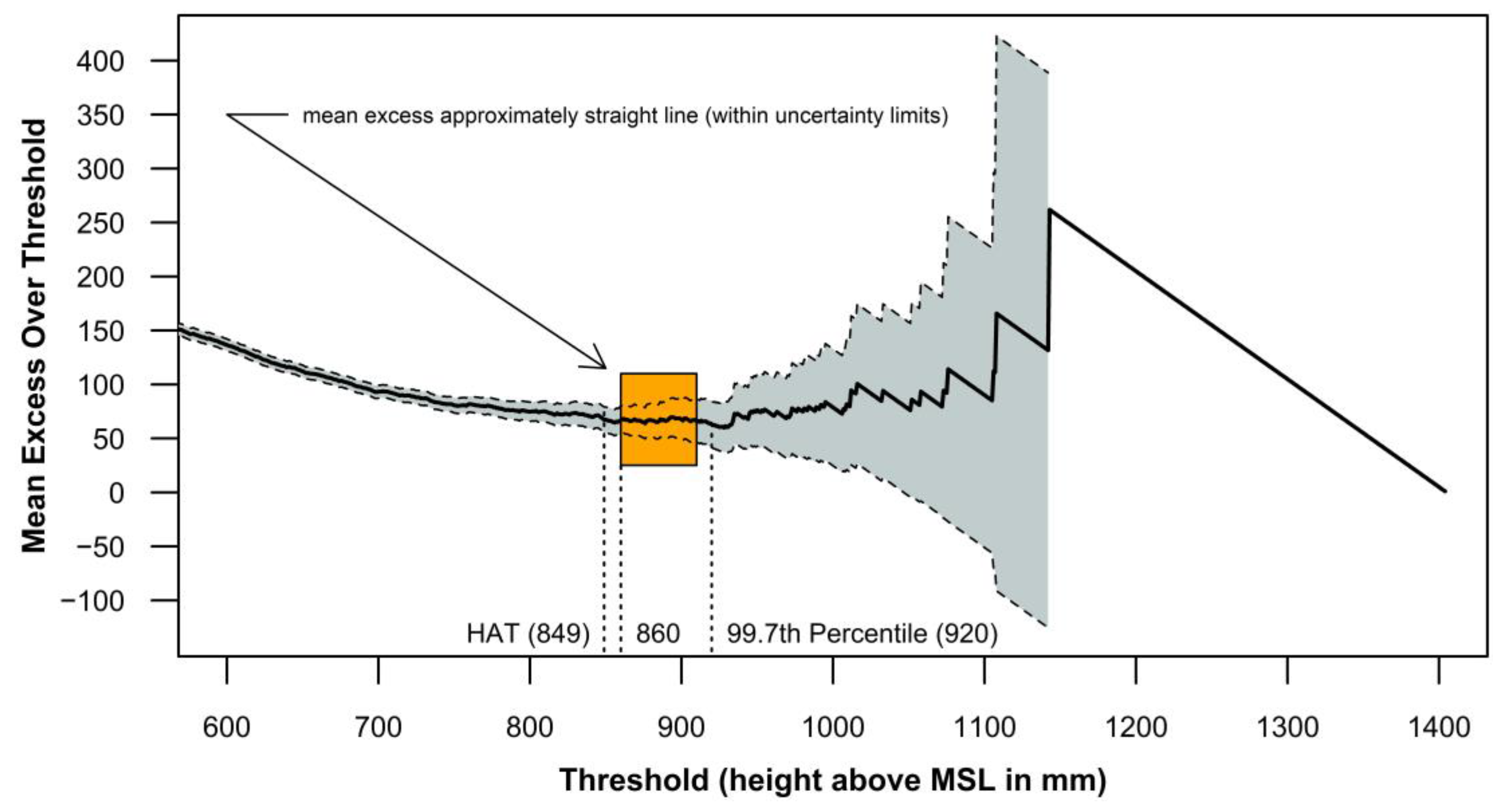
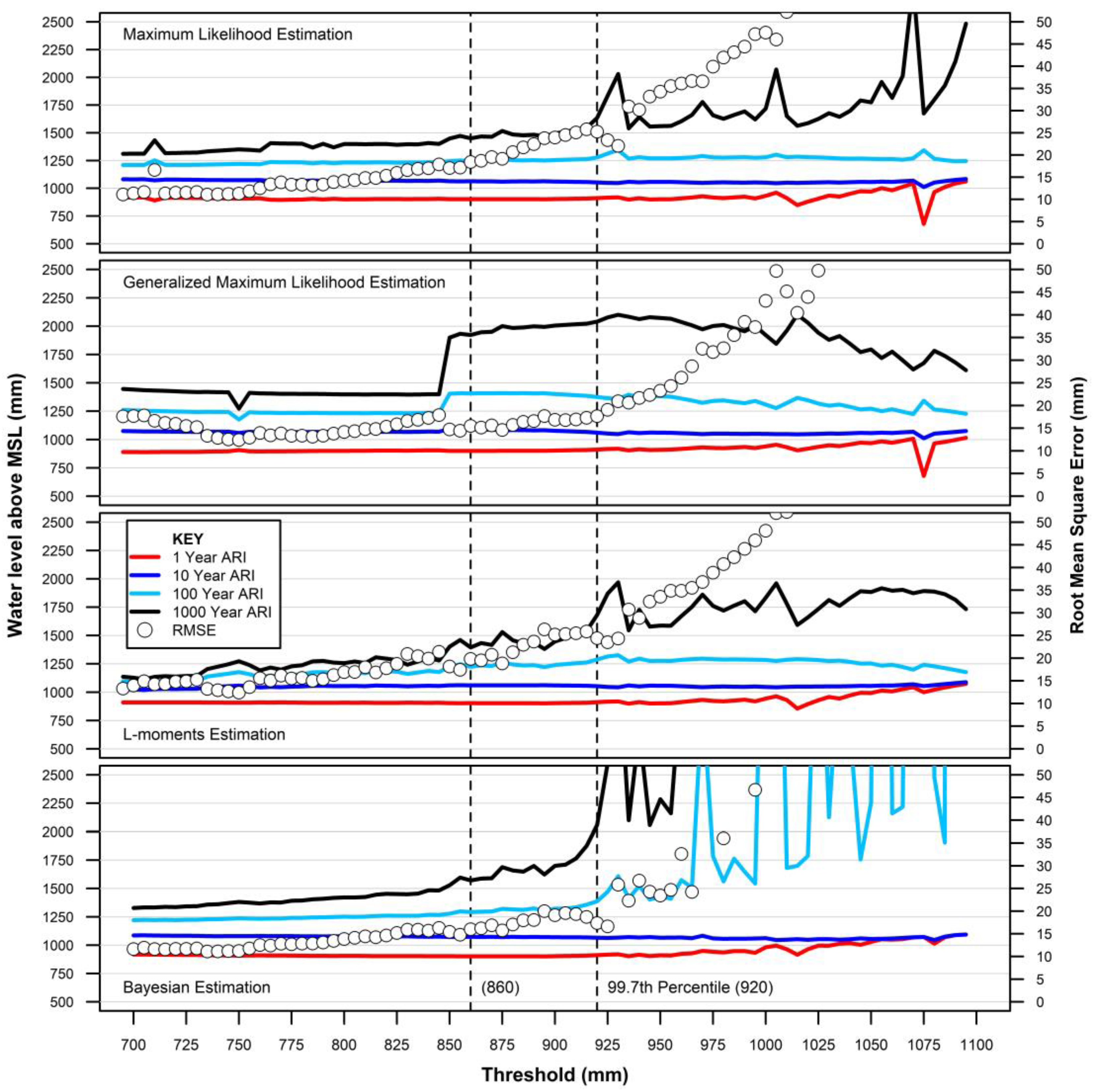
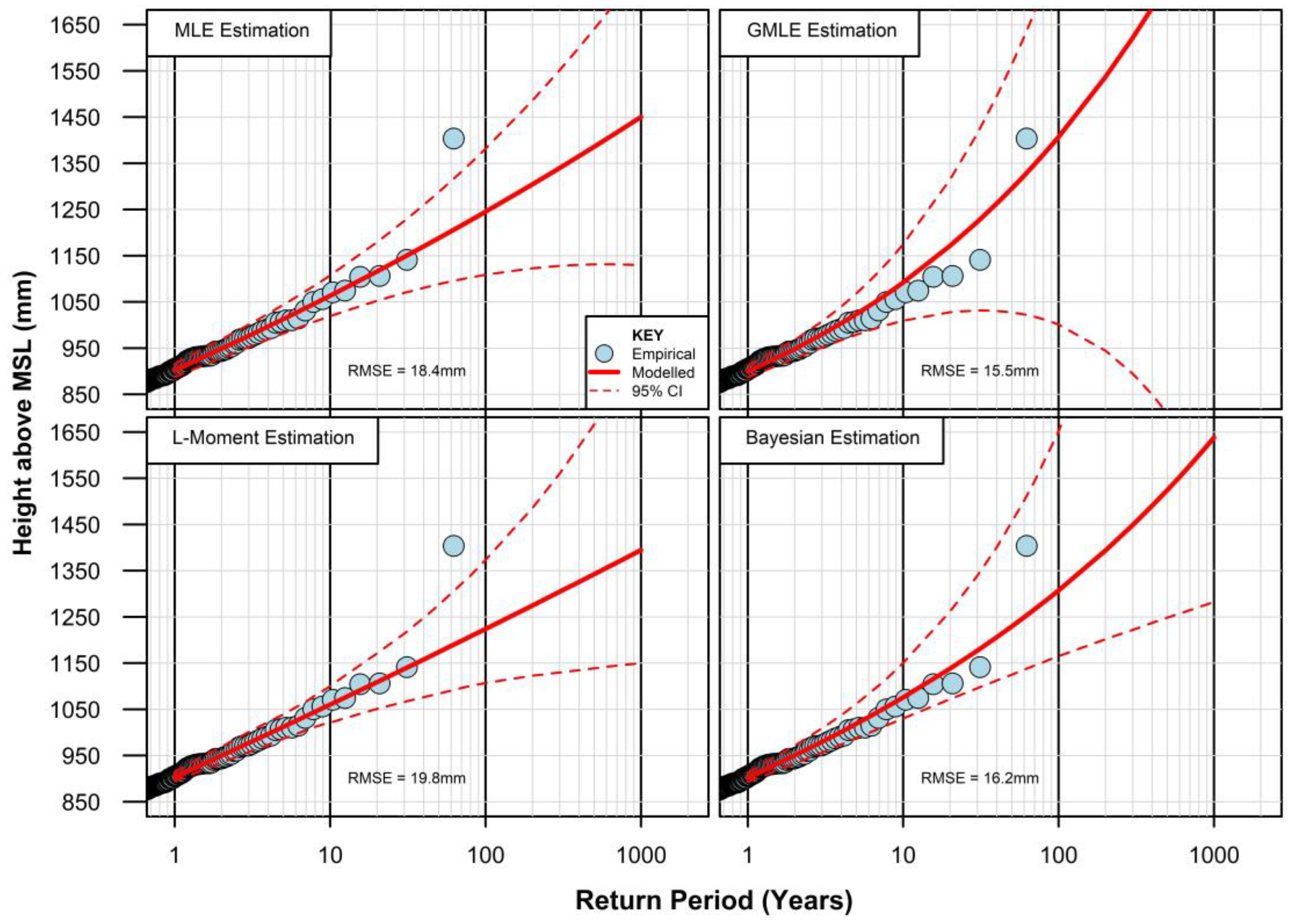

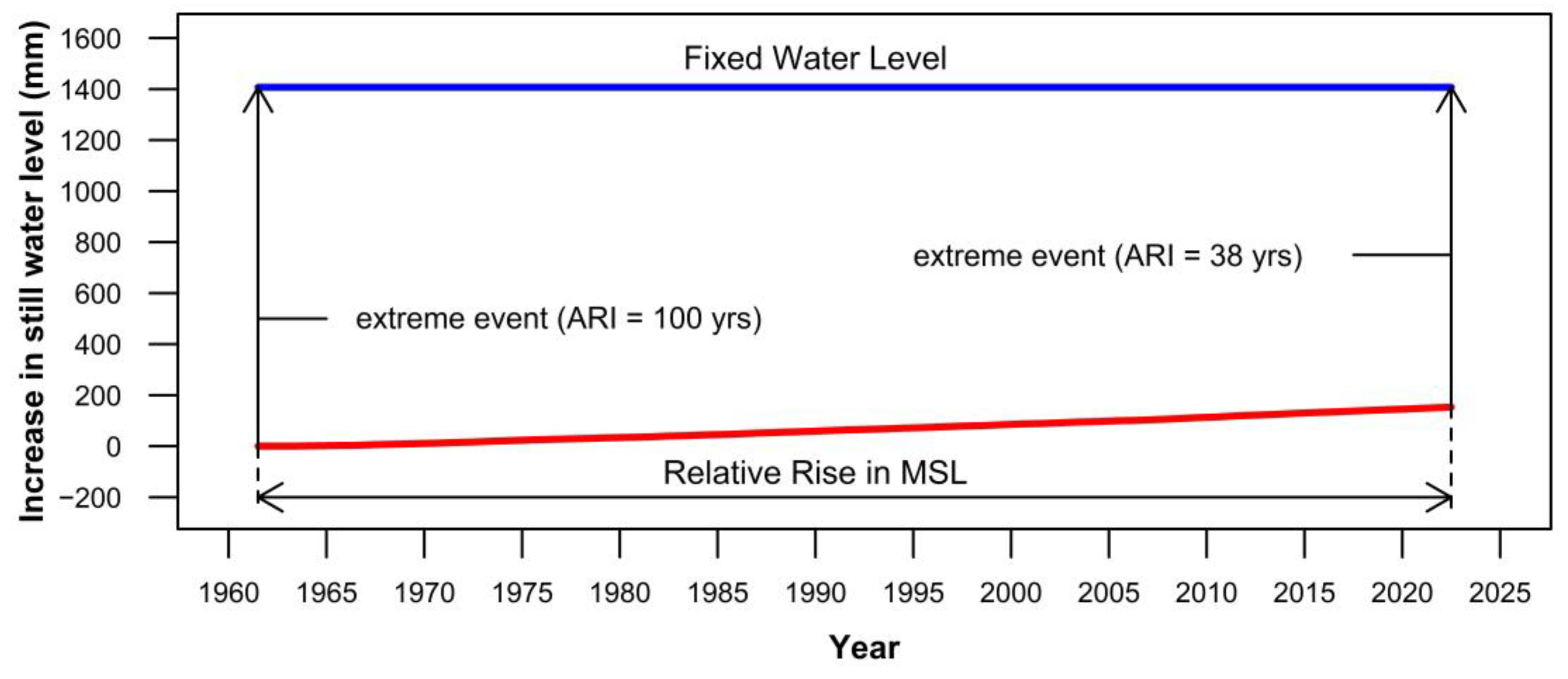
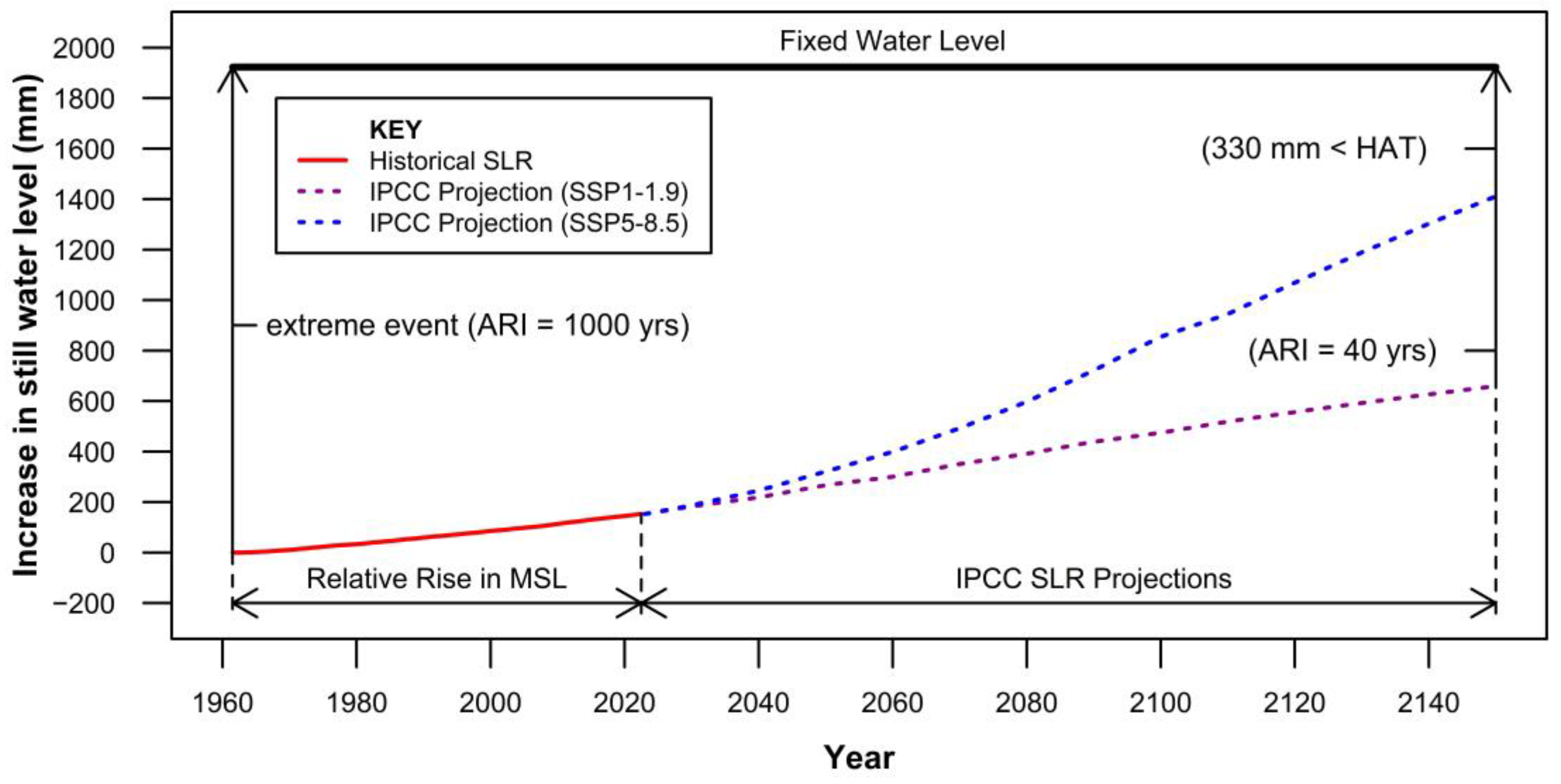
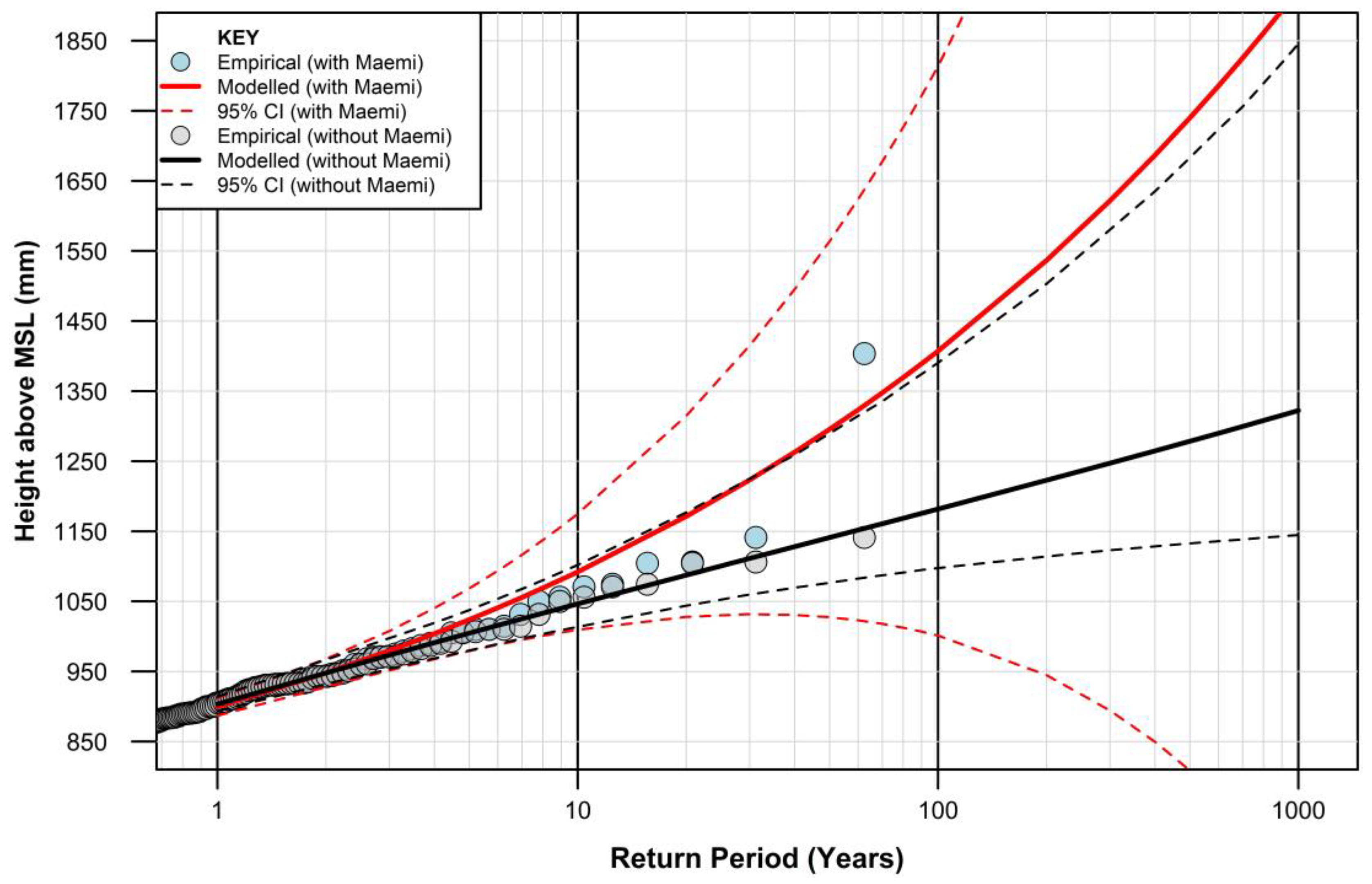
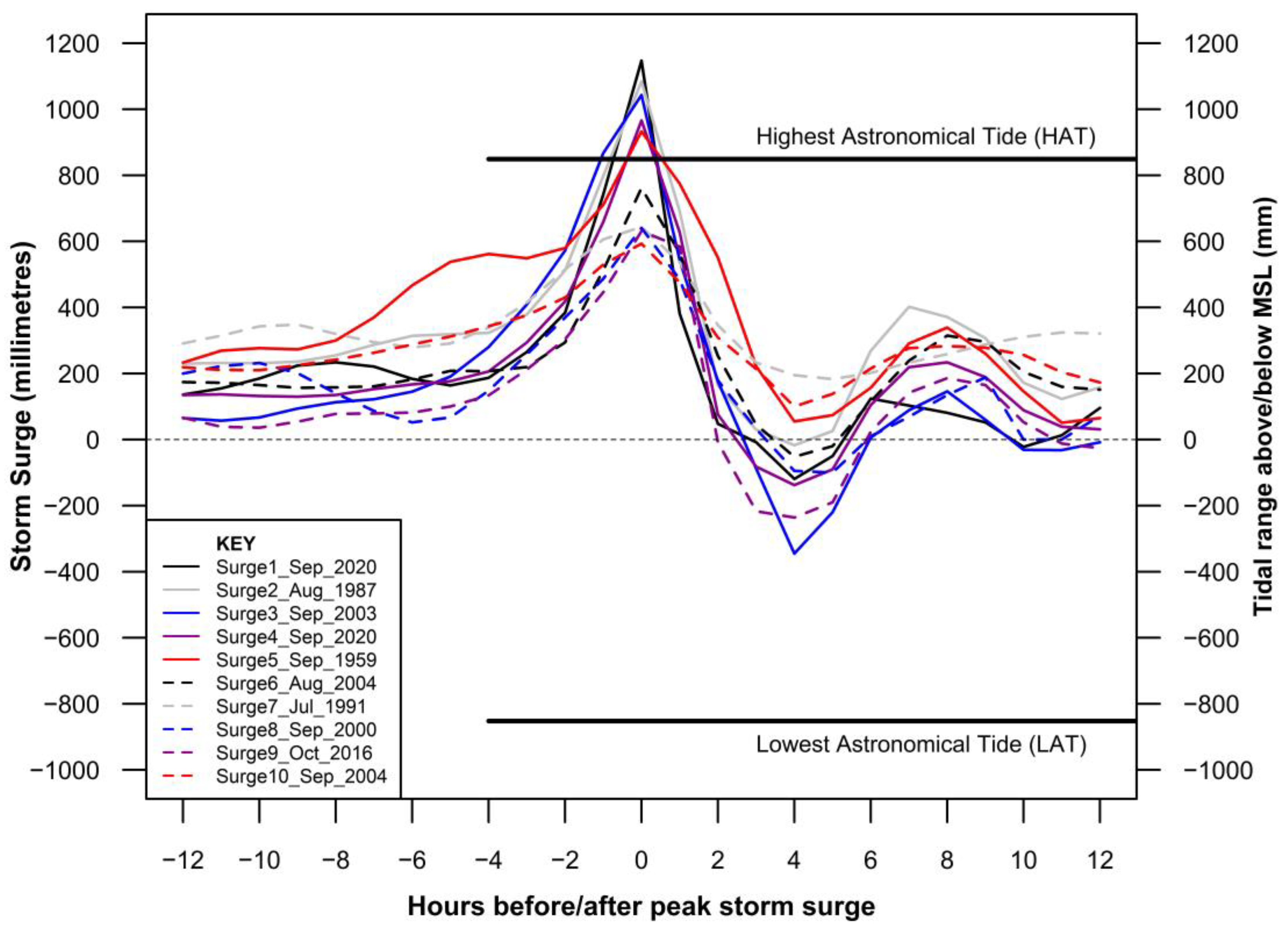
| Rank | Height above MSL (mm) 1 | Date (Time, h) | Typhoon 2 |
|---|---|---|---|
| 1 | 1403 | 12 September 2003 (21:00) | Maemi |
| 2 | 1141 | 22 August 1960 (20:00) | Carmen |
| 3 | 1106 | 17 September 2012 (10:00) | Sanba |
| 4 | 1104 | 6 September 1975 (21:00) | Unknown |
| 5 | 1074 | 6 September 2022 (05:00) | Hinnamnor |
| 6 | 1071 | 2 September 2020 (21:00) | Haishen |
| 7 | 1056 | 23 August 1964 (21:00) | Kathy |
| 8 | 1050 | 27 August 1961 (21:00) | Unknown |
| 9 | 1031 | 8 July 1960 (20:00) | Nadine |
| 10 | 1014 | 23 September 1975 (07:00) | Unknown |
| Recurrence Interval (Years) | Elevation above the MSL (mm) |
|---|---|
| 1 | 900 |
| 2 | 948 |
| 5 | 1024 |
| 10 | 1092 |
| 20 | 1171 |
| 50 | 1296 |
| 100 | 1407 |
| 200 | 1537 |
| 500 | 1740 |
| 1000 | 1923 |
| Year | SSP1-1.9 | SSP1-2.6 | SSP2-4.5 | SSP3-7.0 | SSP5-8.5 |
|---|---|---|---|---|---|
| 2023 | 0 | 0 | 0 | 0 | 0 |
| 2030 | 30 | 30 | 31 | 32 | 34 |
| 2040 | 66 | 74 | 80 | 83 | 93 |
| 2050 | 114 | 127 | 142 | 153 | 168 |
| 2060 | 148 | 170 | 200 | 220 | 246 |
| 2070 | 198 | 228 | 268 | 304 | 340 |
| 2080 | 239 | 276 | 341 | 396 | 445 |
| 2090 | 286 | 324 | 414 | 499 | 569 |
| 2100 | 322 | 374 | 494 | 617 | 702 |
| 2110 | 366 | 435 | 566 | 696 | 792 |
| 2120 | 404 | 483 | 640 | 806 | 916 |
| 2130 | 440 | 529 | 713 | 916 | 1036 |
| 2140 | 474 | 575 | 786 | 1024 | 1150 |
| 2150 | 507 | 619 | 857 | 1128 | 1258 |
Disclaimer/Publisher’s Note: The statements, opinions and data contained in all publications are solely those of the individual author(s) and contributor(s) and not of MDPI and/or the editor(s). MDPI and/or the editor(s) disclaim responsibility for any injury to people or property resulting from any ideas, methods, instructions or products referred to in the content. |
© 2023 by the authors. Licensee MDPI, Basel, Switzerland. This article is an open access article distributed under the terms and conditions of the Creative Commons Attribution (CC BY) license (https://creativecommons.org/licenses/by/4.0/).
Share and Cite
Watson, P.J.; Lim, H.-S. Extreme Value Analysis of Tide Gauge Record at the Port of Busan, South Korea. GeoHazards 2023, 4, 497-514. https://doi.org/10.3390/geohazards4040028
Watson PJ, Lim H-S. Extreme Value Analysis of Tide Gauge Record at the Port of Busan, South Korea. GeoHazards. 2023; 4(4):497-514. https://doi.org/10.3390/geohazards4040028
Chicago/Turabian StyleWatson, Phil J., and Hak-Soo Lim. 2023. "Extreme Value Analysis of Tide Gauge Record at the Port of Busan, South Korea" GeoHazards 4, no. 4: 497-514. https://doi.org/10.3390/geohazards4040028





